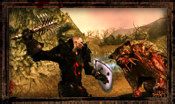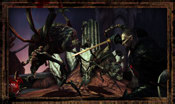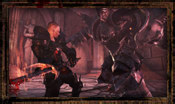"Who are you here to visit?" asks the dowdy 60-year-old customs official at the Edmonton International Airport. "BioWare. They make videoga..." "Oh, BioWare, eh?" the agent interrupts, inking his passport stamp. They're the hottest gamemaker in North America, ya know." He can't wait to get his hands on Mass Something-or-Other for the Xbox 360. Up here, it's hard to find someone who doesn't recognize the name of BioWare, a company founded by two University of Alberta med students looking for more out of life than just a cure for cancer. The blip on BioWare's life-sign monitor traces a bizarre course from medical science to hard science fiction, from Gastroenterology Patient Simulator to
Baldur's Gate and some of the finest PC role-playing games ever. But when the developer detoured into console territory with
Knights of the Old Republic,
Jade Empire, and
Mass Effect, it left the PC faithful wondering whether their beloved BioWare was leaving them behind. So now it falls to
Dragon Age, the company's first PC-only RPG since 2002's
Neverwinter Nights, to set things right. Join us now for the world's first look at this spiritual successor to Baldur's Gate; then hear what BioWare cofounders Greg Zeschuk and Ray Muzyka have to say about roleplaying's past, present, and future. It's only 10 in the morning, but Dragon Age project director Scott Greig has already bled for his game today. "I managed to slice my hand on one of the practice swords," Greig says, pulling the culprit from its sheath, taking care not to disturb the fresh bandage between his thumb and index finger. "Who would have thought they'd be sharp? But it's nice having doctors on the premises...and it's, um, interesting that you can send out an IM to one guy in the company and the next day your office is filled with swords and giant axes." Greig has been with BioWare for nearly 11 years--the first official employee of the company cofounded by doctors/game geeks Greg Zeschuk and Ray Muzyka. Raised as lead programmer on Baldur's Gate and Neverwinter Nights, Greig is no stranger to BioWare role-playing games--or the complex process of making them. And today isn't the first time he's taken up arms for Dragon Age's cause.
"When we started concepting what Dragon Age's combat would be, we wanted to get a tight visual reference for the combat team," he says. "So myself, [lead animator] John Santos, and a couple others got a bunch of swords and shields and sticks and stuff and went to the parkade--the parking lot of one of Edmonton's malls--and set up a video camera on the second floor, looking down, so we could film it from the game point of view. We were out there hitting each other and going, 'I think the shield bash should be like this!' as a bunch of people across the street watched from their balcony with binoculars. Then a woman in a pickup truck came and said, 'What are you doing? This is private property!" and...well, let's say she escorted us off the premises." Greig and Santos show off the fruit of their loiterous LARPing in an early prototype of Dragon Age's tactical combat system. A player character in ratty armor with a shield and sword comes across three ugly orcish things in the street. At first, the camera is behind the player's shoulder--"Explore Mode," Greig calls it--but as the enemies take notice and move in to attack, the camera swings up to a nearly top-down, parkade-inspired perspective. Greig explains that you can issue commands to your party (four characters all told, at least for now) in real time, pause the action, and queue up spells and special attacks--comforting words for anyone who's ventured through Baldur's Gate. As the quartet trades blows, swords clash against swords, and weapons don't just whoosh through the enemy's polygons--they react. When the deadlock breaks, the hero raises his shield to block the foe to the side, and then swivels to the third to knock him to the ground with a shield bash. "We wanted to make sure that when you look at a fight, it's not just swing, swing, swing...we want to make it look like these guys are actually fi ghting and reacting. And we're making sure group combat is really cool--it's not just two guys fighting; you can actually have synchronized attacks with the people around you, too." "Instead of people standing toe-to-toe," adds Santos, "you're actually seeing people duck and move and attack. Every time they get hit, you feel for them because they just got bashed in the head with something really heavy. "Have you ever seen that HBO series Rome? Take a look at the gladiator fight in episode 11 and you'll get a good idea of what we're thinking of." Large-scale combat is also on the top of Greig's mind--no surprise for a game where here, one naturally assumes, there be dragons. "Remember the cave troll fight in The Fellowship of the Ring? That's what our large creature combat is going to be like. You've got the party guys running out, one guy jumping up on the back and stabbing, the other guy ducking between the legs." Objects in the environment can be manipulated in your bid for tactical supremacy: Knock over a table to fire arrows or shoot fireballs from behind cover, but only where it makes sense--emergence be damned, in BioWare's reckoning. "There will be a lot of ways of going through combat, and lots of different ways to interact with the environment...but our philosophy is that handcrafted is always better than random stuff."
DRAGON YEAR ZERO
Step back in time to E3, 2004 AD, when BioWare teased PC RPG fandom with a brief glimpse of Dragon Age for the first (and for the past two-plus years, only) time. "That," explains Greig, "was our proof-of-concept test. We had just finished Neverwinter Nights and were thinking we needed to do something that's gonna be Baldur's Gate, only next-generation--with all the in-depth story stuff, all the characters, only much more cinematic and visceral. We had the idea to put together the exploration view of Knights of the Old Republic and capture the party-based action-packed combat of Baldur's Gate, only in 3D and advanced, so [that demo] was really a test to put that together...we knew it was early, but we wanted to make sure fans knew we were working on PC games, too. We'd just done KOTOR, Jade Empire was coming out, we knew Mass Effect was about to be announced [all for the Xbox or Xbox 360], and we just wanted to reassure our PC fans we hadn't forgotten them." A lot has happened since then. "We've spent the last two to three years just having artists and writers put together what the world is, what the story is for Dragon Age. [Back then], we were still working on the Aurora-engine level--NWN, KOTOR, and even Jade Empire were part of that technology chain--and realized that it wasn't gonna cut it. So we went back to the drawing board and started working on the brand-new engine, the Eclipse engine that's gonna be in Dragon Age." While BioWare is loath to spoil the specifi cs of its world or characters, they're open about their infl uences--we hear George R. R. Martin's A Song of Ice and Fire series spill from more than one pair of lips, and the art direction takes a note from Frank Frazetta's Conan paintings. Folks utter the word "dark" at least four dozen times; "mature," "realistic," and "sophisticated" aren't far behind. "'Dark heroic fantasy' really captures what the world is all about," echoes Greig. "The grittiness, the horror elements, blood, dirt--it's going to be a lot darker than anything we've done in the past. We still wanted to capture the high fantasy elements. There are heroes, villains, obviously dragons--it's called Dragon Age, after all--but it's more than just your standard 'take fantasy elements and toss them together' game. We wanted to make a living, breathing world that actually had a realistic feel to it. If people actually had magic, how would they react to it? If someone could walk into a room and point a finger and turn you into a fireball, this isn't something anyone would take casually. If this were history, and we had these situations with magic and monsters and creatures, how would this work out?" Even the name of the game is meant to ground the fantasy in history--this is the Dragon Age, meant to stand in a line tucked amidst the Bronze Age, Steel Age, and Industrial Age. As in any BioWare game, characters--and moral choices--tower over everything, though Greig says it isn't as simple as light-side points and dark-side points, open palm and closed fist. "Yes, you're the hero, or the antihero, depending on how you play, but it's going to be a lot more organic. You basically have to save the world, but what the world is like when you're done--that's totally up to you and the choices you make throughout the game. You're literally going to decide the fate of nations, who's becoming king, what nations are actually around after...what races are around. You're going to have to make some hard choices in the game, but we want all the choices to be clear. The player's gonna know if he does this, there's a really horrific consequence. Decisions are gonna be hard...and sort of shocking." But before you get to the who lives and who dies, one of the first decisions you need to make is just what kind of character you want to play-- and Dragon Age wants to make sure that, whatever your preferred poison, it's got you covered. "We use a class-based system that has levels--we're staying that close to our D&D roots. You start off with three basic classes, the wizard, fighter, and rogue, just to get you started. Very quickly, you get access to advanced classes, and even within those classes you get to customize abilities, stats, and talents--you buy points, build it up, and after a short while you'll be able to pick even more advanced classes. If you want to have a fighter-type character with magic-like abilities, there'll be a route you can take for that. If you want to be a barbarian berserker, you can do that, too...there's a route for everyone so players can build their character the way they want. There's a stupid number of class abilities and special abilities...I think it's more than in any other BioWare game." While character customization is grand, it poses a conundrum for writers striving to build a better, stronger character-driven narrative: How do you write a story appropriate for both a beer-swigging, meat-inhaling dwarven soldier and a holier-than-thou high elf--without resorting to prison cells, amnesia, or fresh-from-the-boat strangers in a strange land? "We've watched how people play our games," Greig says, "and found there are a few common archetypes people like to play. They'll always play the same character in different settings--if you're the 'elf archer guy,' you play that kind of character in every game. So we looked at the common archetypes and said, 'OK, we're going to let you play your character in the world, and it's going to make sense. So one of the big things we're doing is origin stories." Rather than just offer multiple endings, Dragon Age offers multiple beginnings, too. "Say, for example, you want to be a dwarf--you'll have different choices for what kind of setting in the dwarf environment you start in. So if you pick dwarf noble, then you're part of the royal family in one of the dwarven cities, and that's where we start you off. And you spend the first hour or two of the game interacting with that world. You get to learn all about the dwarves and the plots that are going on, and major things happen to you personally. We also introduce at that point a nemesis for you--not the main villain in the game, but someone who's going to be dogging your footsteps throughout Dragon Age, and eventually you'll have to come face-to-face and deal with him. Your nemesis will be different depending on your origin. "One of the other options is a dwarf commoner--pick that, and you start off working the sort of dwarf underclass. The nobles have their honor, but you start off down in the gritty and real dwarf environment, and you have to struggle through the street stuff...you have to work to forge your place in the underworld of dwarf society. And it's a completely different story-- you'll run into some of the same characters [that] you would as the dwarf noble, but they'll treat you and react to you differently." Once you've played through your chosen origin, world events intersect, and you'll find yourself pulled into the same plot as all the rest--with different twists and side quests based on your roots. "If you go back into the dwarf city, depending on whether you were a dwarf noble or a dwarf commoner or an elf or human from one of the other stories, the NPCs will completely react to you differently with different subplots and different stories that open up for you." "We've basically covered all the major fantasy archetypes," says Greig. "Each race has a classic, traditional origin story, and then we've got one that's a lot more edgy. We're finding in testing that the unusual ones are the ones that people like the most."
WITH FRIENDS LIKE THESE
Behind every good hero stands his chums--and BioWare RPGs are nothing without followers. "Every character will have access to the full set of NPCs," says Greig. "They'll treat you differently depending on the origin story, and when you get them is dependent on origin story too." Characters follow behind you in Explore Mode, and BioWare is strongly pushing the idea of party banter. Greig compares it to Saving Private Ryan: "There's a part [in SPR] when they're just walking though the area not doing anything, but the banter going on really brings them to life. We're trying to capture that." As for A.I., "It's not just me and three meat Popsicles," Greig continues. "These are living, breathing characters...all the NPCs that join you have different agendas. If you say, 'I'll side with this faction,' that'll obviously please some of your party members, but others will say, 'I can't believe you just did that.'" Morally driven banter is one thing (party members in Knights of the Old Republic would often chide you for your dark-side decisions while blindly following your innocent-slaughtering orders) but morally driven behavior is another--and Greig hints that NPCs might even go so far as refuse to fight if they feel you're way out of line. NPC management is similar to that of
KOTOR 2; every major area you enter has a "base camp" with activities that change depending on location, and selecting the appropriate NPC for the location will be important. "When you go into the city, it's probably not the best idea to bring the 9- foot-tall war golem with you," says Greig, pointing to a character modeler's monitor where a large rock creature is on display--an imposing, runecovered "dwarven war golem" named Shale. "This is one of the NPCs that joins you.... The dwarves used to make these guys for their wars, but the art of creating them has been lost. But you run into one of these guys and he gets to join up with the party--and as the prime mover of the world, you have influence over how this guy turns out. You can explore his past and get into the details to make him a living, breathing person--as far as dwarven war golems go--or you can turn him into a blind follower who'll basically kill at your every whim." A Dragon Age analogue to Knights of the Old Republic's space-age HK-47, it seems. "You'll also be able to upgrade him--carve new dwarven runes into him to gain new powers. You'll be able to customize every one of the party members in some way." Down the hall, Greig shows off a "visual fidelity" test--an impressive blue-tinged torture chamber where stained glass windows pour colored light on the wall and sunlight flickers on the floor in distorted waves. "The art philosophy is 'fantasy painting come to life,'" says Greig, invoking Frazetta once again. "It's dark. It's gritty...it's all about dirt and texture detail." Over by the in-game wall, he points out "the best barrels you'll see in a videogame...running on a high-end PC, you'll see the level of detail...[we're definitely thinking about] DirectX 10 and beyond." A giant disfigured blue demon plays bouncer at the door. "The artists went a little bit overboard with him," says Greig. "You can actually see a reflection of the room in his eyes. They also actually went down and did scrollwork on the [treasure] chests," he says, zooming in ultra-close to reveal detailed elvish runes on thin strips of metal. "One of the reasons for this test was to figure out how much is too much." But when it comes to character close-ups and conversation, detail can make or break the deal. "There are two ways to go in the game industry for cinematics," says Steve Gilmour, director of animation and cinematics. "You go can go the sizzle, prerendered cinematic route, but because we're a story-driven game company, and because we allow you to build characters however you want them to be dressed and with whatever weapon that you've given them, we focus on in-game cinematics." Even now, in-game cinematics often means blocky figures with triangular mouths and cut-rate lip-synching--but BioWare is way ahead of the curve when it comes to crafting convincing digital actors. Dragon Age uses a modified version of the Mass Effect conversation system, much lauded at last year's E3, in which characters' facial expressions speak at least a hundred words, lips synch convincingly to speech, and dialogue trees are distilled into bullet-point "ideas" and "tones" rather than complete sentences to make conversations flow at a more natural pace. "Ours is customized to do just what we need it to do," says Greig, "and we've got some ideas on how to make it Dragon Age.specific and work for the mouse and PC. The writing in a fantasy game is different from [that in] science fiction. In Mass Effect, they're going for a 24-ish, modern type of dialogue. The language is much richer in texture in a fantasy game. The voice actors are going to be busy, that's for sure. "Back in Baldur's Gate, if a character needed to be angry, the writers had to write angry words. Then we got to voice acting, and so the words themselves didn't have to be angry; you could just have the actors read in an angry voice. Now we actually have a lot more options--you can say an angry word, you can have an angry voice, or you can have the character just sitting there glowering." "A level of storytelling fidelity with digital actors that we've never really had before," says Gilmour. "That's what I'd say 'next generation' really is."
CRITICAL HITS
BioWare tends to roll 20s. "We've had the opportunity to work with some of the best licenses, IPs, and world settings," says Greig. "We worked with D&D, Star Wars...and those have been great. The license holders have been good about letting us create stuff in their worlds. But no matter what you do, someone else actually owns it, and you have to respect their wishes and desires. And we'd come up with killer ideas that just didn't fit into those world settings. If you're building your own, it gives you a chance to explore those themes. "There's been a great tradition of D&D; a lot of our fans grew up playing it, [and] we've grown up using it, but we wanted to do something more in line with a modern audience...like the old Battlestar Galactica series compared to the new one--how they've taken the same themes, characters, setting, and brought it to modern sensibilities." For Greig, that's something worth bleeding for.
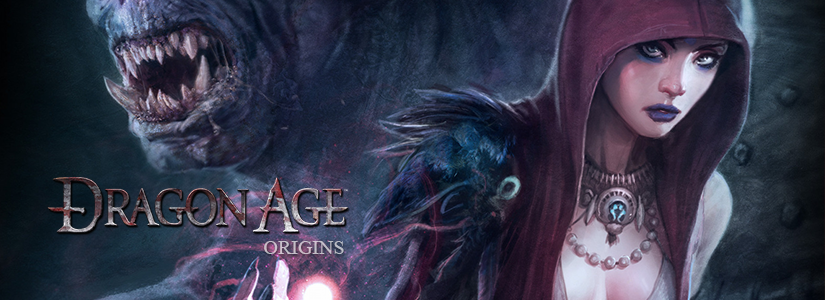
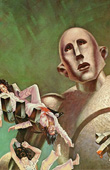 Xzander
Xzander Dragn
Dragn Sonic
Sonic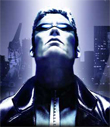 p1xeL
p1xeL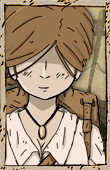 Женечка
Женечка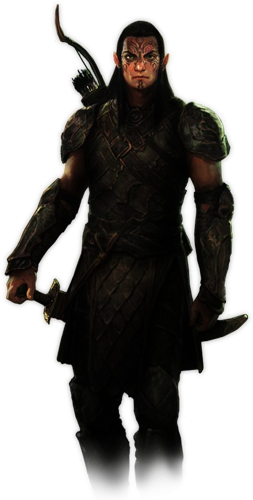









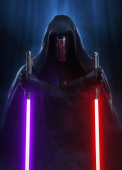 TiRTo
TiRTo